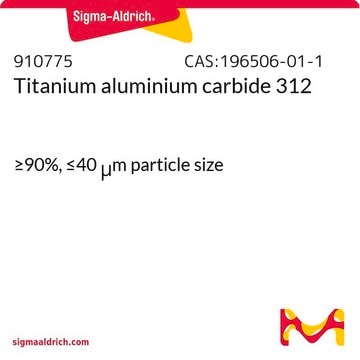If this product has an expiration or retest date, it will be shown on the Certificate of Analysis (COA, CofA). If there is no retest or expiration date listed on the product's COA, we do not have suitable stability data to determine a shelf life. For these products, the only date on the COA will be the release date; a retest, expiration, or use-by-date will not be displayed.
For all products, we recommend handling per defined conditions as printed in our product literature and website product descriptions. We recommend that products should be routinely inspected by customers to ensure they perform as expected.
For products without retest or expiration dates, our standard warranty of 1 year from the date of shipment is applicable.
For more information, please refer to the Product Dating Information document: https://www.sigmaaldrich.com/deepweb/assets/sigmaaldrich/marketing/global/documents/449/386/product-dating-information-mk.pdf
921408
Titanium Carbide MXene dispersion in propylene carbonate
Synonym(s):
Titanium Carbide MXene
About This Item
Recommended Products
form
dispersion
Quality Level
concentration
≥0.5 mg/mL in propylene carbonate
color
faint gray to black
application(s)
battery manufacturing
storage temp.
−20°C
General description
Application
Signal Word
Warning
Hazard Statements
Precautionary Statements
Hazard Classifications
Eye Irrit. 2
Storage Class Code
10 - Combustible liquids
WGK
WGK 1
Choose from one of the most recent versions:
Certificates of Analysis (COA)
Don't see the Right Version?
If you require a particular version, you can look up a specific certificate by the Lot or Batch number.
Already Own This Product?
Find documentation for the products that you have recently purchased in the Document Library.
Articles
Optimizing the synthesis of high-quality 2D MXene flakes for 3D ink printing is essential to such technological developments as printable and flexible electronics.
Discover how MXenes' superior conductivity, strength, and stability are revolutionizing energy. Explore their potential for next-gen batteries and hydrogen evolution.
Discover how MXenes' superior conductivity, strength, and stability are revolutionizing energy. Explore their potential for next-gen batteries and hydrogen evolution.
Discover how MXenes' superior conductivity, strength, and stability are revolutionizing energy. Explore their potential for next-gen batteries and hydrogen evolution.
-
How can I determine the shelf life / expiration / retest date of this product?
1 answer-
Helpful?
-
-
How is shipping temperature determined? And how is it related to the product storage temperature?
1 answer-
Products may be shipped at a different temperature than the recommended long-term storage temperature. If the product quality is sensitive to short-term exposure to conditions other than the recommended long-term storage, it will be shipped on wet or dry-ice. If the product quality is NOT affected by short-term exposure to conditions other than the recommended long-term storage, it will be shipped at ambient temperature. As shipping routes are configured for minimum transit times, shipping at ambient temperature helps control shipping costs for our customers. For more information, please refer to the Storage and Transport Conditions document: https://www.sigmaaldrich.com/deepweb/assets/sigmaaldrich/marketing/global/documents/316/622/storage-transport-conditions-mk.pdf
Helpful?
-
-
What is the concentration of this dispersion? Is it readily usable or does it require any centrifuging or sonication?
1 answer-
This product is ready to use, no sonication or further preparation is required. The minimum concentration specification is 50 mg/mL. The exact value is reported on a lot-specific Certificate of Analysis.
Please see the link below to access a sample or lot specific Certificate:
https://www.sigmaaldrich.com/product/aldrich/921408#product-documentation.Helpful?
-
-
Do we have to synthesise it further or it’s ready to use. What would the Tx in this. Is it soluble in DMF or Acetic acid.
1 answer-
This product is ready to use and no further synthesis is required. The Tx surface termination groups can be Cl, F, and OH. This product is not tested for solubility, however, a study has been performed in Chemistry of Materials, 29(4), 1632-1640 (2017).
See the image below to review the results.Helpful?
-
Active Filters
Our team of scientists has experience in all areas of research including Life Science, Material Science, Chemical Synthesis, Chromatography, Analytical and many others.
Contact Technical Service








